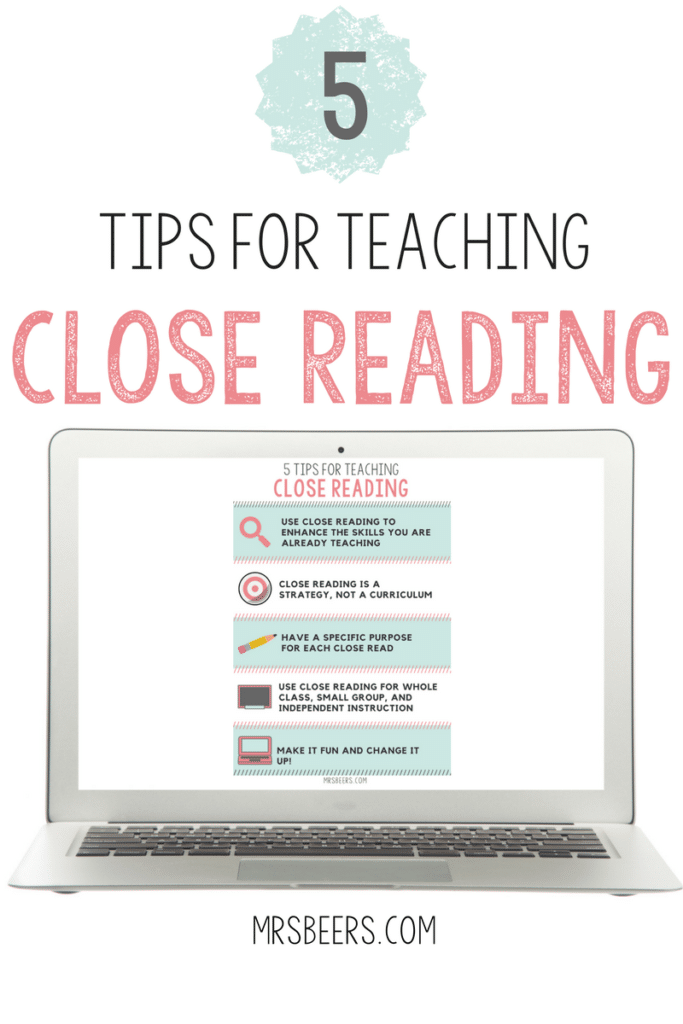
5 TIPS FOR TEACHING CLOSE READING
This week we officially tackle the 4th quarter of the school year. Classroom procedures are automatic, expectations are ever-present, and student ownership over learning has reached a new level. Isn’t it the greatest feeling in the world when our students are enthusiastic, engaged, AND showing growth? I can think of few things that are more thrilling as a teacher. OK, treats in the teacher’s lounge is up there, but a distant, distant second…
Close reading is a reading strategy that I utilize with my students ALL YEAR, but during test-prep time, it gets a bit more focus. If you are looking for a way to enhance your students’ work with close reading, here is how I utilize this reading strategy…

We are fortunate to live in an age where we have quick and easy access to information. At times we are bombarded by news and information and we are forced to move so quickly in order to navigate everything that is shared with us or sent our way. I observe this fast-pace with my students and this was the week to enlist the great SLOW DOWN that is close reading. With each text structure, we took the time to navigate an informational text selection using our close reading skills. If you are looking to incorporate close reading into your classroom, here are a few tips and techniques for how I tackle it in my middle school classroom using both printable and digital resources.
Tip #1: Use close reading to enhance the skills you are already teaching!
Close reading is a reading strategy that works best when used alongside the learning your students are already tackling. Best practice is not giving our students reading passage after reading passage and having them respond to the text-based questions that accompany the selection. Instead, find passages that enhance the work you are doing with students.
During our work with order and sequence, I shared an informational text on How to Make a Valentine. Through the close reading process, my students and I could read the selection multiple times in order to identify: clue words of order and sequence, the organization of the text, and make any connections to the title and process shared in the text. The one page, high-interest selection kept their focus and targeted the skill of being able to identify characteristics of informational text that has the order and sequence text structure.
Tip #2: Close reading is a strategy, not a curriculum.
In my ELA classroom, my focus is on helping my students enhance their LOVE of reading. While reading one-two page passages is a PART of our learning, it is NOT THE CORE of what we do each day. Our core ELA curriculum includes literature circles, read alouds, and self-selected reading. My GOAL is to enhance my students love of reading and help them become life-long readers. My work, however, incorporates teaching specific skills that my students MUST have to be thoughtful and critical readers as they analyze and respond to text, which is where mini-lessons and close reading come into play.
Tip #3: Have a specific purpose for each close read.
Do your students need greater focus on citing evidence from a text? Are you wanting students to make connections to make sense of what they are reading and physically mark up their reading selections? Do you want students to enhance their work with literal questions? When you are seeking out reading selections to share, have a specific purpose for making your selection. Don’t have students close reading just to keep them busy. They will grow to hate it and the benefit is completely diminished.

Tip #4: Use close reading as whole class, small group, or independent instruction.
My students have very diverse reading levels, skill sets, and needs. I have some students that grasp concepts very quickly and easily, while others take more time to show their understanding. While I teach the close reading process to ALL of my students, not everyone needs to be reading text multiple times and marking it up to show their thinking ALL OF THE TIME.
We used close reading as a whole group this week in order to navigate the different text structures. I used close reading with an intervention group as I retaught in small groups, and I allowed students to close read for independent practice. It is essential to differentiate the need for close reading instruction to meet my students’ reading needs.

Tip #5: Make it FUN and CHANGE it UP!!
To enhance their enjoyment of close reading, I teach my students FRUIT! The FRUIT acronym is an easy way for my students to remember all that I want them to do when tackling a passage using close reading. It is memorable and can be done with both digital and printable reading selections.
If you are looking for digital tools so your students can read articles on-line and annotate their thinking News ELA is an ideal tool. Students are able to highlight, annotate, and respond to the prompt shared in the Write section. News ELA is an awesome site that offers teachers that opportunity to print and share the articles through email or Google Classroom. If you are looking to find high-interest, leveled informational text, News ELA is an ideal site to check out.

As you work to target and enhance your students reading skills, close reading is perfect tool to add to your teacher tool belt! Happy Close Reading!

